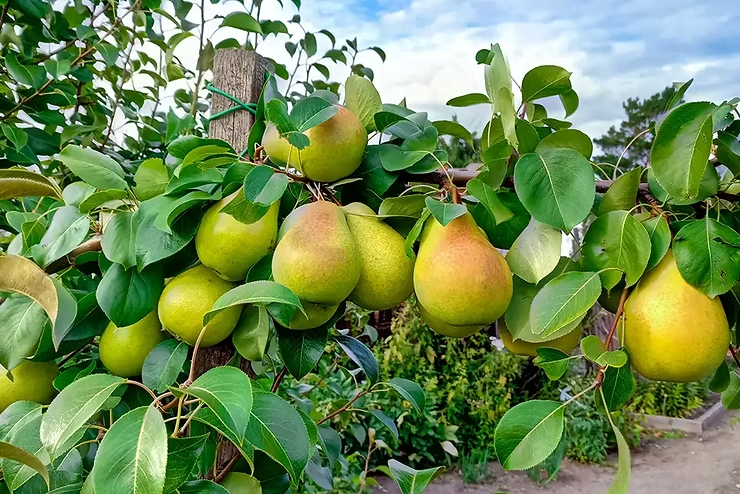Experts say the U.S. should look for demand growth and new market opportunities. Why? This past...
U.S. Pear Harvest Expected to Be Much Larger than 2024

The chill of deep winter freezes and late spring frosts have thawed to a much larger expected pear harvest this year, according to USA Pears. And the difference is substantial: 2025 could deliver yields that jump 60% from the weather-related woes of a year ago.
The bigger harvest comes at a time of great uncertainty for the industry following the shock of the shutdown of a Del Monte Foods’ pear cannery in Yakima, Washington. Some growers in the region were left with no market for their pears. And that left fruit rotting in the orchards as pears piled up.
Del Monte Pears Cannery Closes in Washington
The Del Monte facility once processed more than 50,000 tons of pears annually, according to Northwest Public Broadcasting. But once the Yakima facility shut down in August, 51 full-time workers lost their jobs, the company declared bankruptcy, and that blocked Edgar Hernandez’s pear pathway.
Hernandez, a farmer in Moxee, told Northwest Public Broadcasting, “It’s pretty much a hundred percent loss, and that’s a big impact for us.”
Hernandez and other pear growers could not see this coming, according to Jon DeVaney, President of the Washington State Tree Fruit Association. Once the Yakima cannery shut down, it only left one remaining cannery in the state: Northwest Packing Company.
“Growers had to then struggle to find alternate customers,” DeVaney told Northwest Public Broadcasting. “If you were a pear grower growing for the canning market, it created a lot of dislocation,” he said.
Del Monte Bankruptcy
On July 1st, Del Monte described in a news release about its financial future: “…pursuing a value-maximizing sale process as part of an overall strategic balance-sheet restructuring.”
The decision for the 140-year-old company to file for Chapter 11 bankruptcy proceedings included the disclosure that Del Monte stated that it had $912.5 million in debtor-in-possession financing.
That included $165 million in new funding, "This is a strategic step forward for Del Monte Foods,” said Greg Longstreet, President and CEO of Del Monte Foods. “After a thorough evaluation of all available options, we determined a court-supervised sale process is the most effective way to accelerate our turnaround and create a stronger and enduring Del Monte Foods.”
Longstreet added, “With an improved capital structure, enhanced financial position and new ownership, we will be better positioned for long-term success."
While that would hopefully provide Del Monte with a better chance in the future, it likely does little to lessen concerns from pear producers in the country’s Northwest region.
USDA to Buy $20 Million in Northwest Bartlett Pears
Washington and Oregon grow 88% of the country’s pears, according to USA Pears. So, the announcement that the USDA will buy up to $20 million in produce from Northwest Bartlett pear growers could provide some comfort to the reeling region after Del Monte’s Yakima cannery ceased operations.
The USDA’s Section 32 purchase brought appreciation from CarrieAnn Arias, President and CEO of USA Pears. "Our growers in Washington and Oregon are excited about the quality and quantity of this year's crop, and their enthusiasm is contagious as they bring more than 10 varieties and an abundant volume of fruit to market well into 2026," she told The Produce News.
Arias continued, “The USDA's Section 32 buy of Bartlett pears will enable food banks and school nutrition programs to gain access to the nutritious fruit. Along with a bountiful supply, USA Pears is introducing a refreshed brand image with a new logo and consumer insights. The team is gearing up to implement innovative strategies to catapult consumption and make pears the go-to fresh fruit snack Americans crave."
EDITOR’S TAKE:
Typically, a large, bountiful harvest is welcomed by growers. In the case of pears, it appears it is a perfect storm that looms with excess production and industry setbacks. The timing of the Del Monte financial situation could not have been worse. Government, while able to help some with purchases for school lunch programs, cannot be a total substitute for regular consumer market sales. It is a good sign that promotions and image campaigns are being developed to assist with marketing this year’s crop – the question becomes – will it be enough?
Now is a great time for you, as a CAD member, to make sure your promotional materials are up to date. Do you have the latest list of AgPack® partners with a brief description of their offers? What about your ability to promote CADFI and CAD Protect? And have you checked to make sure your inventory on AgTruckTrader.com® is current? It pays to stay on top of these programs so you’re ready to answer any questions from those farmers/ranchers.







